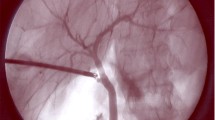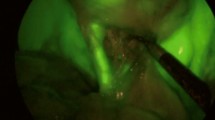Abstract
Purpose
Near infrared cholangiography (NIRC) with indocyanine green (ICG) directly injected into the gallbladder is a novel technique to outline biliary anatomy. The purpose of this article is to analyze the usefulness and feasibility of NIRC as a safety method during laparoscopic cholecystectomies.
Material and methods
A case-controlled study comparing 20 patients undergoing laparoscopic cholecystectomies with NIRC with direct injection of ICG into the gallbladder to 20 consecutive standard cholecystectomies. Operative time, length of stay, complications, conversion rates, and biliary injury were analyzed.
Results
Both groups were comparable in epidemiological characteristics. In the ICG group fluorescent visualization of the junction of the Hartmann pouch and the whole cystic duct was achieved in 16 (80%) patients. Median surgical time was 65 (50–76) and 55 (45–71) min for the ICG and the control group, respectively (p = 0.113). There were no postoperative complications and no biliary duct injuries in any of the groups, and a patient from both groups underwent conversion to open surgery.
Conclusion
NIRC with direct injection of ICG into the gallbladder is a feasible method that is not time-consuming; it does not require a different learning curve from standard laparoscopic cholecystectomies and has no major complications described so far.



Similar content being viewed by others
References
Pucher PH, Brunt LM, Fanelli RD, Asbun HJ, Aggarwal R (2015) SAGES expert Delphi consensus: critical factors for safe surgical practice in laparoscopic cholecystectomy. Surg Endosc 29:3074–3085. https://doi.org/10.1007/s00464-015-4079-z
Ministerio de Sanidad Servicios Sociales e Igualdad. Actividad y Calidad de los Servicios Sanitarios, informe anual del SNS 2017. 2018;1–77. Available from: https://www.mscbs.gob.es/estadEstudios/estadisticas/sisInfSanSNS/tablasEstadisticas/InfAnualSNS2017/5_CAP_17.pdf
Hogan NM, Dorcaratto D, Hogan AM, Nasirawan F, McEntee P, Maguire D, Geoghegan J, Traynor O, Winter DC, Hoti E (2016) Iatrogenic common bile duct injuries: increasing complexity in the laparoscopic era: a prospective cohort study. Int J Surg 33:151–156. https://doi.org/10.1016/j.ijsu.2016.08.004
Boogerd LSF, Handgraaf HJM, Huurman VAL, Lam HD, Mieog JSD, Van Der Made WJ et al (2017) The best approach for laparoscopic fluorescence cholangiography: overview of the literature and optimization of dose and dosing time. Surg Innov 24:386–396. https://doi.org/10.1177/1553350617702311
Strasberg SM (2002) Avoidance of biliary injury during laparoscopic chelocystectomy. J Hepato-Biliary-Pancreat Surg 9:543–547. https://doi.org/10.1007/s005340200071
Conrad C, Wakabayashi G, Asbun HJ, Dallemagne B, Demartines N, Diana M, Fuks D, Giménez ME, Goumard C, Kaneko H, Memeo R, Resende A, Scatton O, Schneck AS, Soubrane O, Tanabe M, van den Bos J, Weiss H, Yamamoto M, Marescaux J, Pessaux P (2017) IRCAD recommendation on safe laparoscopic cholecystectomy. J Hepatobil Pancreat Sci 24:603–615. https://doi.org/10.1002/jhbp.491
Lammert F, Acalovschi M, Ercolani G, van Erpecum KJ, Gurusamy KS, van Laarhoven CJ et al (2016) EASL Clinical Practice Guidelines on the prevention, diagnosis and treatment of gallstones. J Hepatol 65:146–181. https://doi.org/10.1016/j.jhep.2016.03.005
Boni L, David G, Mangano A, Dionigi G, Rausei S, Spampatti S, Cassinotti E, Fingerhut A (2015) Clinical applications of indocyanine green (ICG) enhanced fluorescence in laparoscopic surgery. Surg Endosc 29:2046–2055. https://doi.org/10.1007/s00464-014-3895-x
Graves C, Ely S, Idowu O, Newton C, Kim S (2017) Direct gallbladder Indocyanine green injection fluorescence cholangiography during laparoscopic cholecystectomy. J Laparoendosc Adv Surg Tech 27:1069–1073. https://doi.org/10.1089/lap.2017.0070
Araki K, Namikawa K, Mizutani J, Doiguchi M, Yamamoto H, Arai H, Yamaguchi T, Ido Y, Uno K, Hayashi N (1992) Indocyanine green staining for visualization of the biliary system during laparoscopic cholecystectomy [3]. Endoscopy. 24:803. https://doi.org/10.1055/s-2007-1010592
Pesce A, Piccolo G, La Greca G, Puleo S (2015) Utility of fluorescent cholangiography during laparoscopic cholecystectomy: a systematic review. World J Gastroenterol 21:7877–7883. https://doi.org/10.3748/wjg.v21.i25.7877
Vlek SL, van Dam DA, Rubinstein SM, de Lange-de Klerk ESM, Schoonmade LJ, Tuynman JB, Meijerink WJHJ, Ankersmit M (2017) Biliary tract visualization using near-infrared imaging with indocyanine green during laparoscopic cholecystectomy: results of a systematic review. Surg Endosc 31:2731–2742. https://doi.org/10.1007/s00464-016-5318-7
Liu YY, Kong SH, Diana M, Lègner A, Wu CC, Kameyama N, Dallemagne B, Marescaux J (2016) Near-infrared cholecysto-cholangiography with indocyanine green may secure cholecystectomy in difficult clinical situations: proof of the concept in a porcine model. Surg Endosc 30:4115–4123. https://doi.org/10.1007/s00464-015-4608-9
Agnus V, Pesce A, Boni L, Van Den Bos J, Morales-Conde S, Paganini AM et al (2019) Fluorescence-based cholangiography: preliminary results from the IHU-IRCAD-EAES EURO-FIGS registry. Surg Endosc 34:3888–3896. https://doi.org/10.1007/s00464-019-07157-3
Mitsuhashi N, Kimura F, Shimizu H, Imamaki M, Yoshidome H, Ohtsuka M, Kato A, Yoshitomi H, Nozawa S, Furukawa K, Takeuchi D, Takayashiki T, Suda K, Igarashi T, Miyazaki M (2008) Usefulness of intraoperative fluorescence imaging to evaluate local anatomy in hepatobiliary surgery. J Hepato-Biliary-Pancreat Surg 15:508–514. https://doi.org/10.1007/s00534-007-1307-5
Liu YY, Liao CH, Diana M, Wang SY, Kong SH, Yeh CN, Dallemagne B, Marescaux J, Yeh TS (2018) Near-infrared cholecystocholangiography with direct intragallbladder indocyanine green injection: preliminary clinical results. Surg Endosc 32:1506–1514. https://doi.org/10.1007/s00464-017-5838-9
Ishizawa T, Fukushima N, Shibahara J, Masuda K, Tamura S, Aoki T, Hasegawa K, Beck Y, Fukayama M, Kokudo N (2009) Real-time identification of liver cancers by using indocyanine green fluorescent imaging. Cancer. 115:2491–2504. https://doi.org/10.1002/cncr.24291
Ishizawa T, Saiura A, Kokudo N (2016) Clinical application of indocyanine green-fluorescence imaging during hepatectomy. HepatoBiliary Surg Nutr. https://doi.org/10.21037/hbsn.2015.10.01
Dip F, Falco J, Montesinos MR, De La Fuente M, Rosenthal RJ (2016) Cost-effective analysis of near infrared (NIR) vs radiotracer for sentinel lymph node biopsy in breast cancer. J Am Coll Surg 223:e3. https://doi.org/10.1016/j.jamcollsurg.2016.08.010
Author information
Authors and Affiliations
Contributions
All authors contributed to the study conception and design. Material preparation, data collection, and analysis were performed by Clara Gené Škrabec and Fernando Pardo Aranda. The first draft of the manuscript was written by Clara Gené Škrabec, and all authors commented on previous versions of the manuscript. All authors read and approved the final manuscript.
Corresponding author
Ethics declarations
Conflicts of interest
The authors declare that they have no conflict of interest.
Ethical approval
This prospective chart review study involving human participants was in accordance with the ethical standards of the institutional and national research committee and with the 1964 Helsinki Declaration and its later amendments or comparable ethical standards.
Consent to participate
Informed consent was obtained from all individual participants included in the study.
Consent for publication
Patients signed informed consent regarding publishing their data and photographs.
Additional information
Publisher’s note
Springer Nature remains neutral with regard to jurisdictional claims in published maps and institutional affiliations.
Electronic supplementary material
ESM 1
(JPEG 383 kb)
Rights and permissions
About this article
Cite this article
Gené Škrabec, C., Pardo Aranda, F., Espín, F. et al. Fluorescent cholangiography with direct injection of indocyanine green (ICG) into the gallbladder: a safety method to outline biliary anatomy. Langenbecks Arch Surg 405, 827–832 (2020). https://doi.org/10.1007/s00423-020-01967-z
Received:
Accepted:
Published:
Issue Date:
DOI: https://doi.org/10.1007/s00423-020-01967-z




